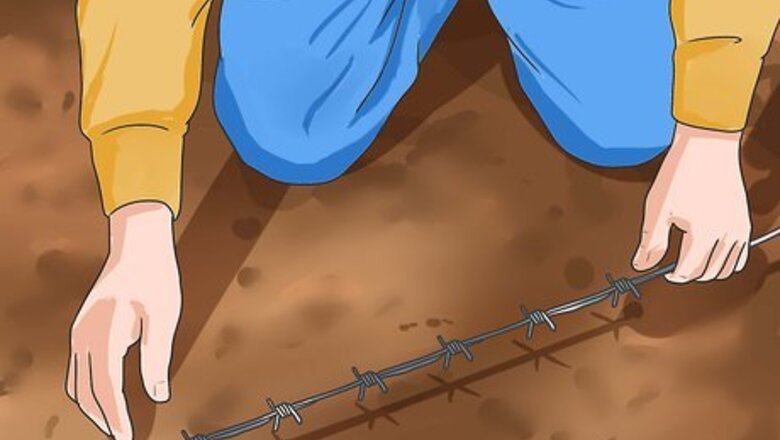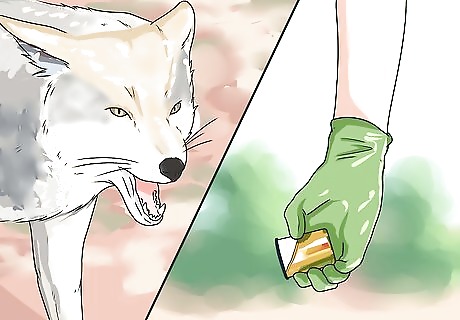
views
X
Research source
As the numbers of coyotes increase, they're becoming more courageous and adaptive to our human-shaped environments and they're less easily intimidated. With brave coyotes starting to venture farther out of the forest and into rural areas and campsites, we have both a need and a responsibility to deter them from built environments or where humans are undertaking activities, in order to avoid harm to either humans or coyotes.

Use fencing. It is recommended that the fence be at least 6 feet (1.8 meters) high, and also extend 1 foot (30cm) underground. The vertical spacing of such a fence should be no more than 4 inches (10cm). Since coyotes are so smart, they will sometimes jump over, or dig under fences. This is often the case on livestock farms, where the temptation is so great that a hungry coyote will do anything to get in. Barbed wire placed at ground level can deter the coyote from digging under the fence. Yards and livestock can be protected from coyotes if the fence is high and deep enough. Be sure to keep the livestock inside the fence, or have someone on proper guard if they are being moved or are feeding somewhere else for some time. More expensive fencing includes underground aprons and overhangs; these can be reserved for feedlots, a shelter area, corrals, or a confinement area to save on costs. Electric fencing can provide a very useful option at a reasonable price for surrounding large areas of livestock. Provide a secure shelter for livestock overnight. Llamas and donkeys can be used as guard animals for livestock protection. The donkey should be a jenny or a gelded jack; ungelded jacks are too aggressive. In the case of donkeys and llamas, care needs to be taken that they're not able to socialize with other donkeys or llamas or they may neglect their livestock herd. Multi-species grazing can offer protective benefits, such as having sheep, goats, and cattle together rather than separated.

Try sound. Sound can have an excellent impact on a coyote that has wandered into your yard or campsite. Try banging trash can lids or anything else that is noisy to scare the coyote off. Yell and make a lot of noise in any way possible. Motion activated alarms can be useful. An even more tech-savvy option is the new Anti-Coyote sound system. This system relies on the fact that cougars occasionally kill coyotes. The systems emit replicated cougar sounds, and may keep coyotes away. Propane exploders can be used to deter coyotes on farms and ranches.

Use negative reinforcement or the element of surprise if you happen across a coyote in your yard or campsite. As well as the noise steps above, there are some other things you can try when you discover a coyote in your locale. Coyotes dislike novel stimuli and frightening tactics can scare them off initially. However, you should never make eye contact with the coyote, turn your back to it, or run away from it, as these will signal aggression or offer a temptation to chase and attack. If you wish to leave, do so calmly, or try one of these scaring off tactics: Spray the coyote with a water hose. Make yourself appear terrifying with noise and lots of body movements; wave your arms about, kick your legs up. This will let them know that you are the boss, and to stay away. Use children's toys that make noise, such as bangs, whirs, jingles, etc. Use motion activated lighting that will be triggered by the coyote crossing a particular area of the yard. Having lighting on from dusk to dawn can deter coyotes from entering the lit area. There are also strobe lights with sirens which can deter coyotes if used in accordance with the manufacturer's instructions. While a vehicle can temporarily deter coyote behavior, especially if moved about a lot, it can also act as a hiding spot (or blind) prior to attack, so be careful about relying on this method.

Eliminate food sources liked by coyotes. While coyotes love flesh food (especially rodents), they are very opportunistic feeders and will eat anything they come across. As such, it's important to make it impossible to get food from our environs. Before all else, never try to feed a coyote as a means to try to tame it or help it; feeding it is simply reinforcing poor behavior that will encourage them to return and will not tame them. Some of the ways you can keep down food sources around your yard or campsite include: Keep all garbage in a coyote-proof box or container. Basically if it's secure and cannot be opened with ease, it will deter the coyote. Ask your local municipality for details if your local store cannot help provide such a container. Dispose of all food waste properly both at home or at a campsite. Either place edible waste into a secure garbage container or into a secure compost bin. Do not leave food waste lying around. Pick ripe fruit from your trees and remove fruit that has fallen to the ground before it becomes the subject of a coyote feast.

Keep pets away from coyotes. Cats, dogs, and other pets can present a reason for attacking, mating, or as a potential meal. To protect your pets, if you live in a coyote area or you're camping with a pet, do the following: Keep pets (dogs and cats) in at night and to keep an eye on them during the day, to prevent encounters and to prevent them from being a possible source of the coyote's next meal or attack. Keep pet food inside or away from where a coyote can forage. If you want pets to eat outside, bring in all uneaten food as soon as the pet has finished eating. Spay or neuter your dogs. When dogs are ready for mating, coyotes will try to mate with them. Don't use your dog as a coyote guard dog unless he has been properly trained to do so. Such a dog needs both proper rearing and training to be able to protect livestock from coyote attacks, otherwise he can become prey. Cover fish ponds. Coyotes eat koi fish that are not protected. Don't scatter birdseed around. Even though it doesn't seem like coyote food, coyotes are attracted to birdseed. Collect such birdseed up after the birds have eaten or use a non-spilling method of feeding (keeping it up high) if you want to feed birds.

Remove junk piles from your property. These can serve to hide both predator and prey. Rabbits and other prey liked by coyotes might use junk piles to breed and live in, thereby attracting coyotes. Moreover, coyotes can use junk piles to hide behind before making an attack. Removal of junk piles has several other benefits, such as reducing habitat for snakes, poisonous insects, and spiders or scorpions, and it looks better. Remove all water sources around the yard or campsite; these can attract coyotes.

Try wolf urine. One natural, and innovative answer to the growing coyote problem is the use of wolf urine as a deterrent. Wolves are one of the coyote's natural predators, and coyote populations drop as wolves are reintroduced into an area. Another odor that might deter coyotes is the common mothball or ammonia soaked rags. Place these at strategic locations around the yard or campsite.

If these humane solutions don't help, consider calling in a professional. Many professional wildlife catchers will use live traps, so that the coyote doesn't have to pay with his life for trespassing. However, be aware that relocation isn't effective, so it is much better to provide the barriers suggested above so that you can continue to live in harmony with the coyote population.
















Comments
0 comment